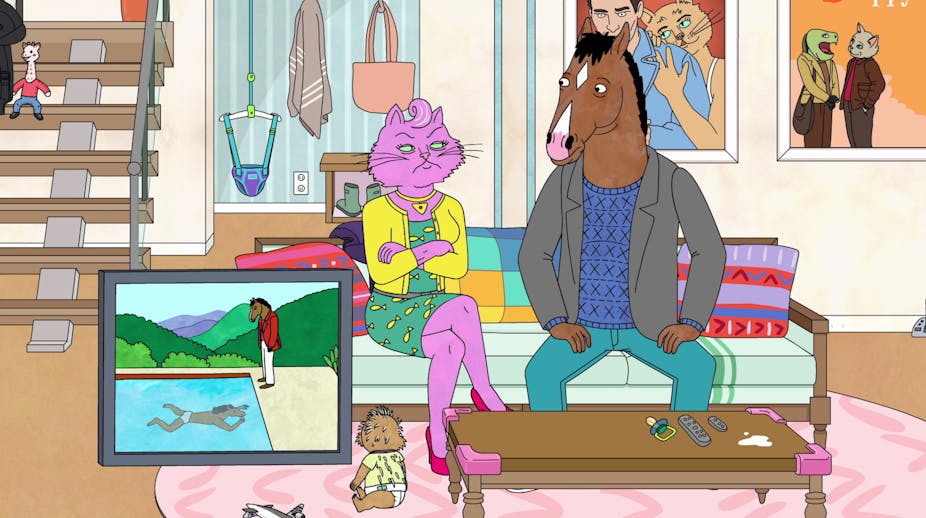Bojack Horseman, an animated series about an alcoholic, fame-obsessed horse, may seem to be utterly contemporary in its innovative blend of dark humour and social satire. However, the techniques it uses stretch as far back as the human imagination. From Aesop’s Fables to Brer Rabbit, storytellers have used animals as effective surrogates to explore and dissect human behaviour.
Released in 2014, the Netflix-produced show has been a hit among audiences and critics alike, praised for the way it tackles subjects such as mental health, addiction and sexuality in frank and innovative ways.
Read more: Netflix's BoJack Horseman is one of the most complex animated characters ever created
The creative use of animals lies at the heart of the show’s appeal and innovation. Bojack lives in the fictitious town of Hollywoo populated by humans and humanoid animals.
Interspecies relationships are common: side plots deal with the star-crossed relationship of a cat and a mouse and the breakdown of a marriage between a dog and a woman. Tongue-in-cheek cameos are made left and right by figures who resemble real-life counterparts, including Quentin Tarantula and Andrew Garfield (who hates Mondays and loves lasagne).
The blurring between animal and human identity allows the show to address many hard-hitting social issues through a comedic, fantastical lens. These techniques make Bojack the show that it is. Nevertheless, they are hardly original.
Animal Fables, Cartoons and Tricksters
In medieval Europe, it was Reynard the Fox who provided a foil to his animal superiors through a combination of wit and cunning. His stories resonated for centuries among the working classes, and formed the inspiration for the first French animation feature, Le Roman de Renard (1930).
In Africa, Anansi the spider offered similar pleasures, delighting people with his skillful wordplay used to turn the tables on powerful Gods and spirits. As these stories travelled to North America during the brutality of the slave trade, they evolved into the Brer Rabbit tales.
Told by one slave to another, these animal tales were reframed to focus on the triumph of the oppressed over the oppressors. Brer Rabbit evaded capture by outsmarting the larger animals who constantly threatened violence on him.
In the 20th century, our fascination with animal stories has become a cornerstone of popular animation. Audiences of the 1920s and 1930s were as familiar with the likes of Felix the Cat and Mickey Mouse as they were with figures like Humphrey Bogart or Katherine Hepburn.
Animation historian David McGowan recently performed an extensive research project on the reception of these talking animals in the United States. He found that these anthropomorphic stars were discussed off-screen as much as their human counterparts, as gossip columnists joined in on the joke and speculated over the sex lives of Mickey, Minnie and Pluto. In a newly liberated climate with changing attitudes to gender and class, it was animals that provided guidance.
On television, the works of Hanna Barbara (The Flintstones and Scooby Doo) and Warner Bros (Looney Tunes and Merrie Melodies) have continued to fascinate audience. The Flintstones was the first animated cartoon to be given a prime time slot on US television. Its use of prehistorical animals as household gadgets came at the same time as the widespread suburbanisation of America.
More recently, shows like Family Guy have continued to experiment with human and animal relationships. The love triangle between Peter, Lois and Brian the dog blurs the boundaries between pet and owner; creating a vision of canine identity that seems in many ways more sophisticated than that of the oafish Peter raised on a diet of popular culture and entitled ignorance.
Understanding from a safe distance
There have been many explanations offered as to why animals are such a constant source of amusement and provocation. Sigmund Freud once argued that our fascination with animals within our collective fantasy lives stems from unconscious associations.
We associate animals with our baser instincts, seeing a form of ourselves in them that we both recognise as similar and yet distant. This makes them an effective tool for helping us make sense of aspects of our lives that we find uncomfortable or confusing.
Bojack borrows from the rich legacy of animal storytelling to both separate us from and entice us into its alternative world of celebrity. Characters within the show are assigned personality traits aligned to their animal status in a way that helps the show perform its social satire.
The banal but loveable Mr Peanutbutter seems forgivably at home in a world of clickbait and viral celebrity. He is, after all, an easily distracted Labrador, chasing his next slice of fame in a manner no more complex than he might chase a ball in his yard.
The spectacle of animals also helps the show tell stories that would be subject to more scrutiny if they were represented by humans. In its six seasons, Bojack has featured storylines about inherited trauma, asexuality, fidelity, child abuse, sobriety and more.
Bojack uses animals to cleverly normalise aspects of our culture that society may be uncomfortable with, such as asexuality, while turning other parts it finds troublesome into extreme bestial caricatures, like the selfishness of celebrity. In doing so, it trades on centuries of well worn storytelling practices, continuing to help us make sense of the world around us by looking towards the animals that populate it.

